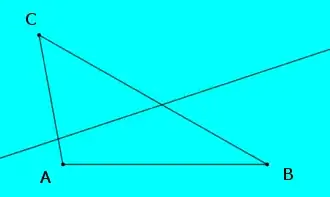$ABC$ is given, and the major axis. How to construct the center of this inellipse of $ABC$ ?
-
1Let $DF$ be the line segment. 1) Strictly speaking, $DF$ isn't the major axis in general : the major axis is included in it 2) Not all segments give rise to an inscribed ellipse (in particular if points $D$ and $F$ are close to a vertex). – Jean Marie Dec 17 '23 at 15:32
-
I agree with you. I've drawn an inellipse, its major axis, and and then I've erased the ellipse. So I'm sure this one exists. – Divertissement Dec 17 '23 at 16:04
-
Is the major axis given in the sense that its length is known, or its endpoints? – Intelligenti pauca Dec 17 '23 at 16:18
-
The "endpoints" of the major axis are given. I'll make another picture. The length is unknown. – Divertissement Dec 17 '23 at 16:29
-
@Divertissement Considering how you came up with the problem, wouldn’t it be possible that the existence of the ellipse depends on the angles of the triangle, and thus it cannot be constructed? – Divide1918 Dec 17 '23 at 16:33
-
I still hope it can be constructed. Another source has just advised me to look into the isogonal conjugation of the major axis. This hyperbola intersects the major axis at the foci. – Divertissement Dec 17 '23 at 17:12
-
Does that construction with a hyperbola solve your problem? Or not? – Intelligenti pauca Dec 18 '23 at 19:39
-
I'm still working on it. – Divertissement Dec 18 '23 at 21:22
-
Thanks Intelligenti pauca ! Exactly the beginning I've heard from, and your picture is very clear. I'm still looking wether we could draw the hyperbola (you wrote "the ellipse" but we understand each other) without calculating its equation. – Divertissement Dec 19 '23 at 17:13
-
I corrected the typo, thanks. It's possible to find axes and foci of the hyperbola with ruler and compass, if you want, see here: https://math.stackexchange.com/a/4827061/255730 – Intelligenti pauca Dec 19 '23 at 17:45
1 Answers
Suppose $F$ and $G$ are the foci of the required ellipse, inscribed in triangle $ABC$. The following property holds for any conic: equal angles are formed by the tangent lines through an external point $P$ with the lines through $P$ and the foci (see here, for instance). That is: $$ \angle CAF=\angle BAG,\quad \angle ACF=\angle BCG,\quad \angle CBF=\angle ABG. $$ By definition, then, $F$ is the isogonal conjugate of $G$ (and vice-versa) with respect to triangle $ABC$. It follows that the isogonal conjugate of the major axis intersects the major axis itself at $F$ and $G$.
If $DE$ is the given line of the major axis, intersecting sides $AB$, $AC$ of the triangle, then its isogonal conjugate is a hyperbola, passing through vertices $ABC$ and through $D'$, $E'$, isogonal conjugates of $D$, $E$. The hyperbola intersects line $DE$ only if $DE$ intersects segments $IB$ and $IC$, where $I$ is the incenter of $ABC$, which is the isogonal conjugate of itself.
To find the center of the inscribed ellipse we can then find the equation of the hyperbola through $ABCD'E'$ and its interections $F$, $G$ with line $DE$ (if any). Center $O$ is the midpoint of $FG$.
- 50,470
- 4
- 42
- 77

